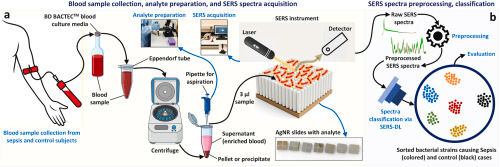Standardizing SERS Instruments with AI: UGA–Qatar University Collaboration Advances Pathogen Detection
- Yiping Zhao
- Sep 23, 2025
- 2 min read
Reliable and rapid pathogen detection remains a major challenge in global health. A recent collaboration between Qatar University (QU) and the University of Georgia (UGA) has taken a meaningful step toward addressing this challenge by improving the consistency of surface-enhanced Raman spectroscopy (SERS) across different instruments. Their joint study, Deep learning-based cross-device standardization of surface-enhanced Raman spectroscopy for enhanced bacterial recognition, published in Spectrochimica Acta Part A: Molecular and Biomolecular Spectroscopy, presents a deep learning framework designed to make portable SERS devices more comparable to laboratory-grade systems.
🔍Addressing Variability in SERS Measurements
SERS is a powerful technique that can detect pathogens at very low concentrations. Despite this promise, its widespread use has been slowed by differences in results from one instrument to another. Portable Raman devices, while accessible and practical, often produce data that do not match the reliability of expensive laboratory-grade equipment. This makes it difficult to apply SERS consistently in clinical or point-of-care settings.
To address this, the QU–UGA team developed a two-part framework:
SERS-D2DNet – a model that translates spectra from portable devices into forms that resemble those from high-performance lab instruments.
SuperRaman – a lightweight classifier that helps identify bacterial signatures with improved accuracy.
Together, these tools reduced errors across devices and improved the ability of portable systems to classify bacterial analytes.
💡A Partnership Built on Complementary Strengths
This work reflects the value of bringing together expertise from different institutions and disciplines. Researchers from Qatar University’s College of Engineering and College of Medicine contributed their strengths in biomedical engineering, device testing, and AI model design. Meanwhile, collaborators from UGA’s Department of Physics and Astronomy provided long-standing expertise in nanofabrication, particularly in creating reliable silver nanorod (AgNR) substrates for SERS.
By combining these complementary skills, the team was able to develop an approach that is both technically sound and practically oriented toward real-world use.
👉What the Study Found
The joint framework showed promising results:
Improved consistency – Spectral transformation achieved correlations above 98–99% with laboratory references.
Higher accuracy – The classifier reached nearly 100% accuracy in bacterial recognition after transformation.
Portable and efficient – The models are lightweight, requiring minimal storage and computational resources, making them well suited for deployment on handheld devices.
While these findings are encouraging, the team views them as a step forward rather than a final solution. Continued efforts will be needed to extend the approach to other pathogens, patient samples, and clinical conditions.
🔭Looking Ahead
This project underscores the importance of international collaboration in solving complex scientific and healthcare challenges. By working together, researchers from Qatar and Georgia were able to demonstrate a practical pathway for making SERS more consistent and reliable across devices. Ultimately, the hope is that such efforts will contribute to more accessible and dependable diagnostic tools, especially in settings where laboratory infrastructure is limited.
Citation: Sakib Mahmud, Faizul Rakib Sayem, Manal Hassan, Yanjun Yang, Muhammad E. H. Chowdhury, Susu Zughaier, Faycal Bensaali, Yiping Zhao, “Deep learning-based cross-device standardization of surface-enhanced Raman spectroscopy for enhanced bacterial recognition,” Spectrochimica Acta A 347, 126931 (2025).






Comments